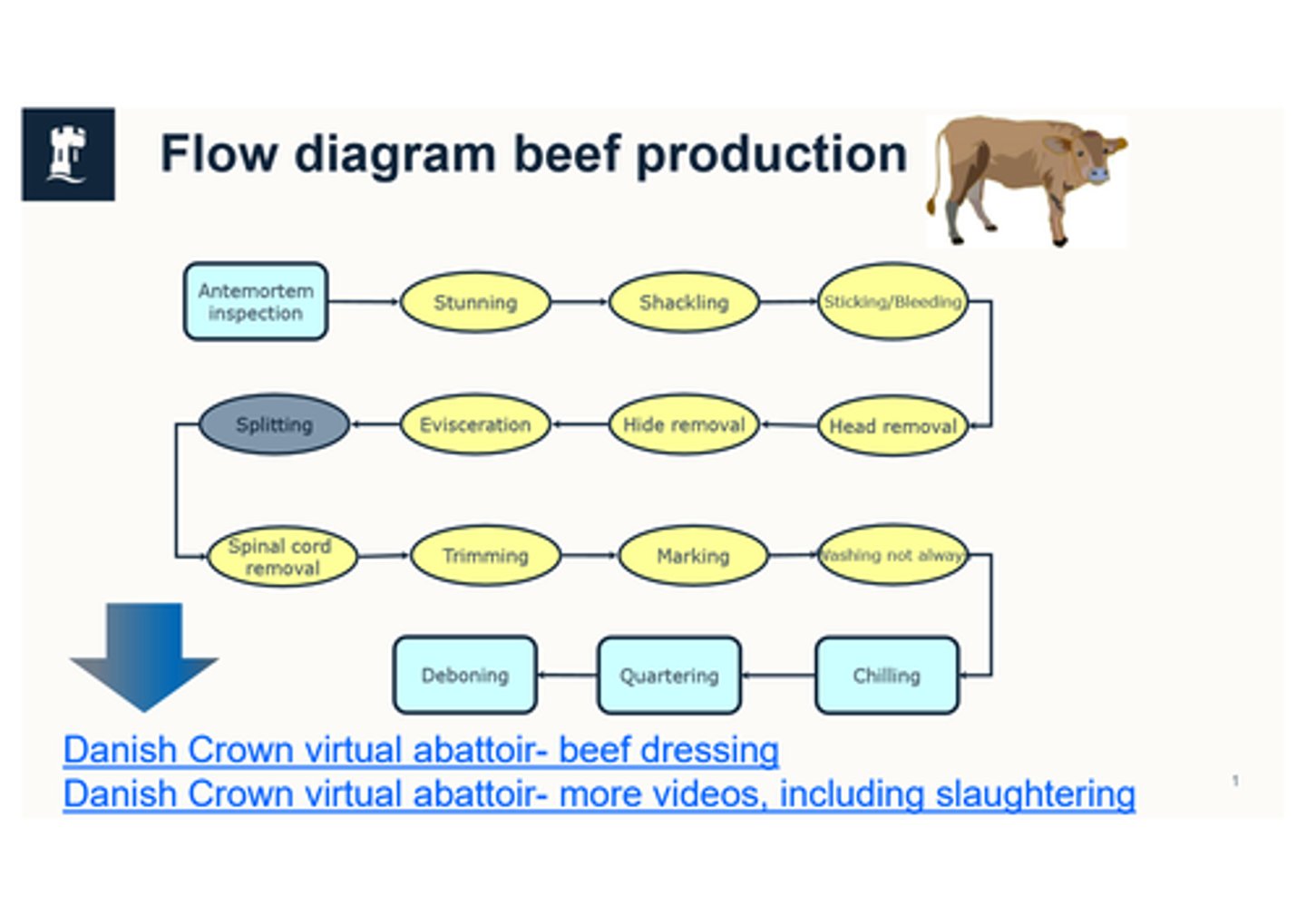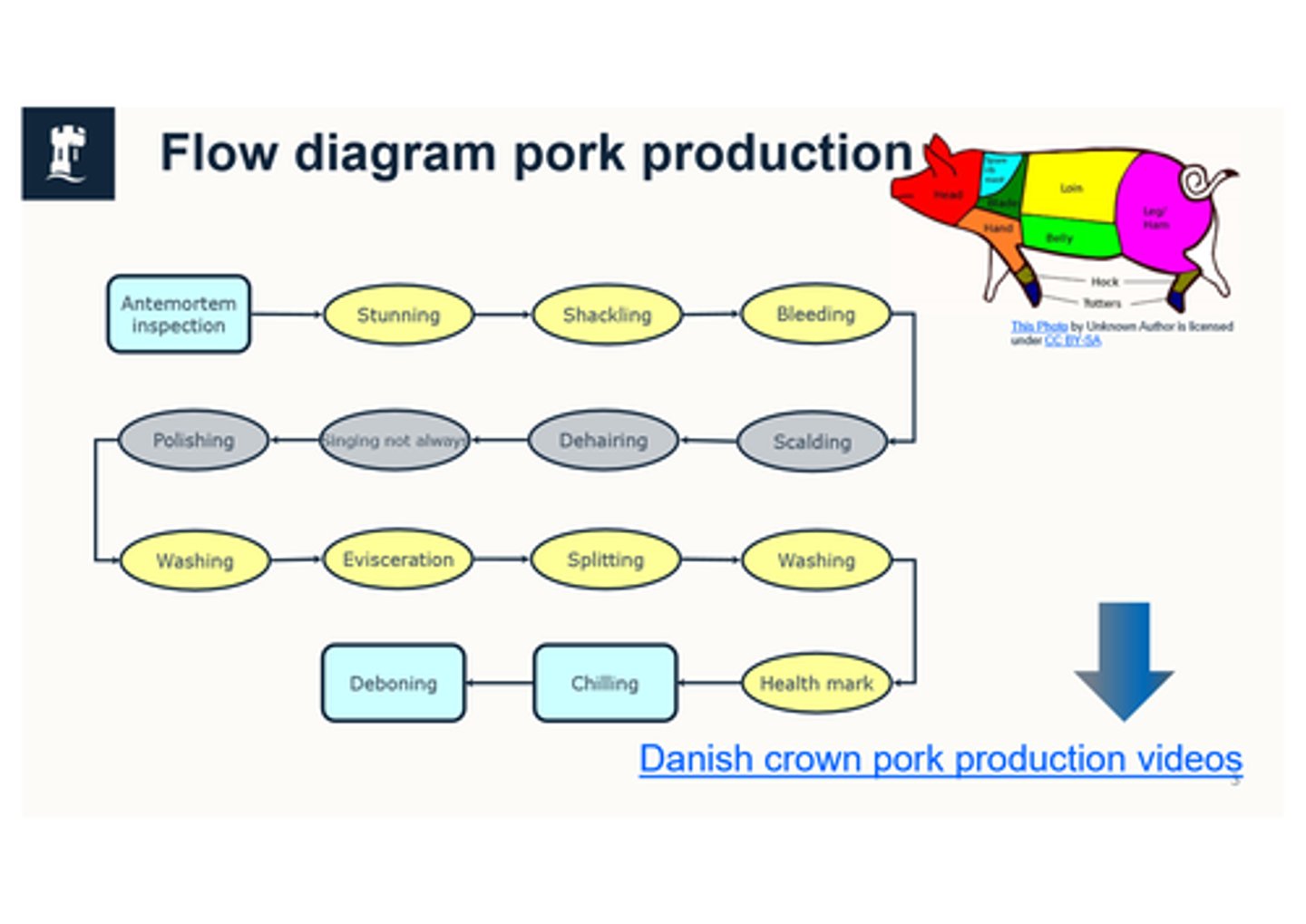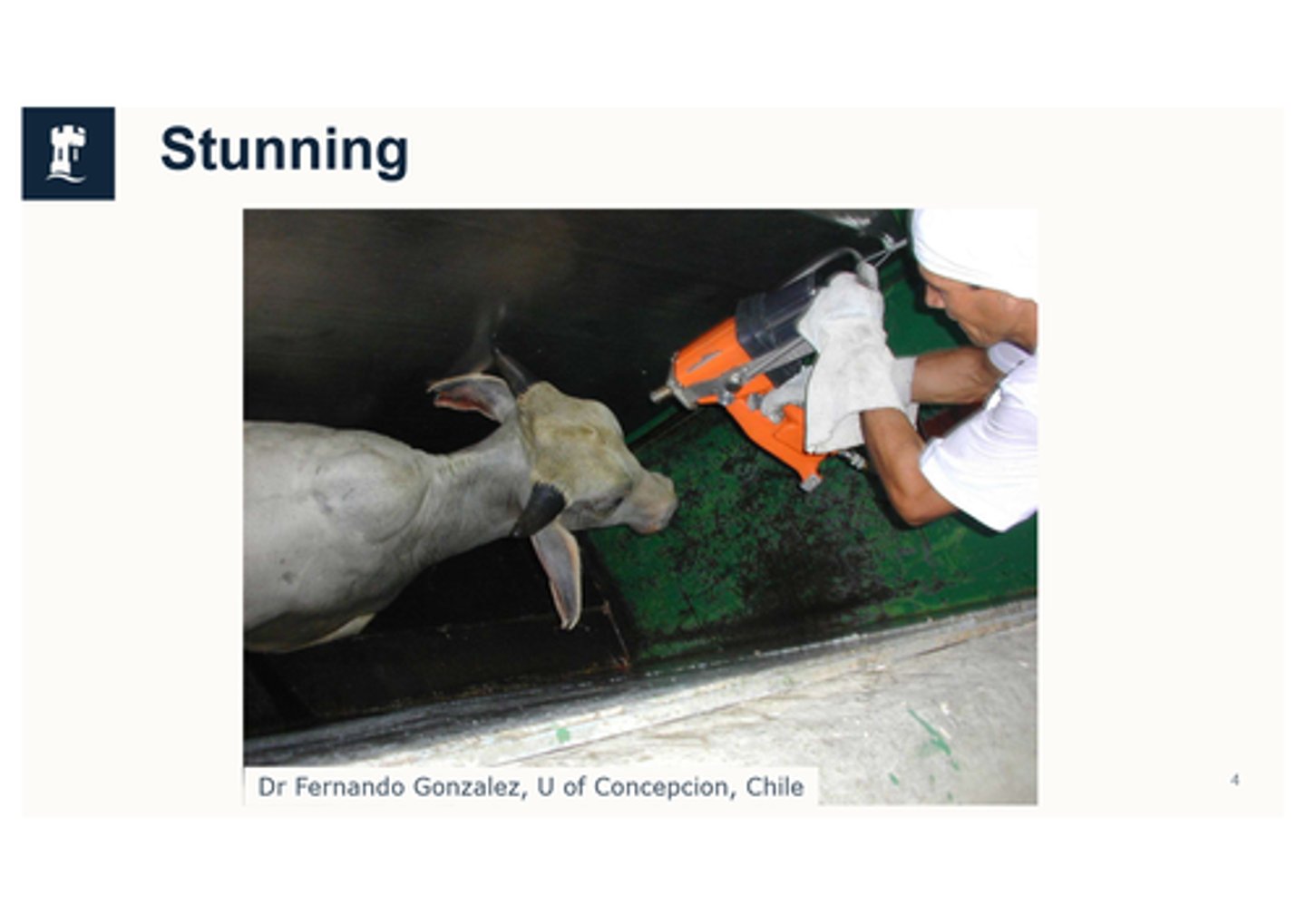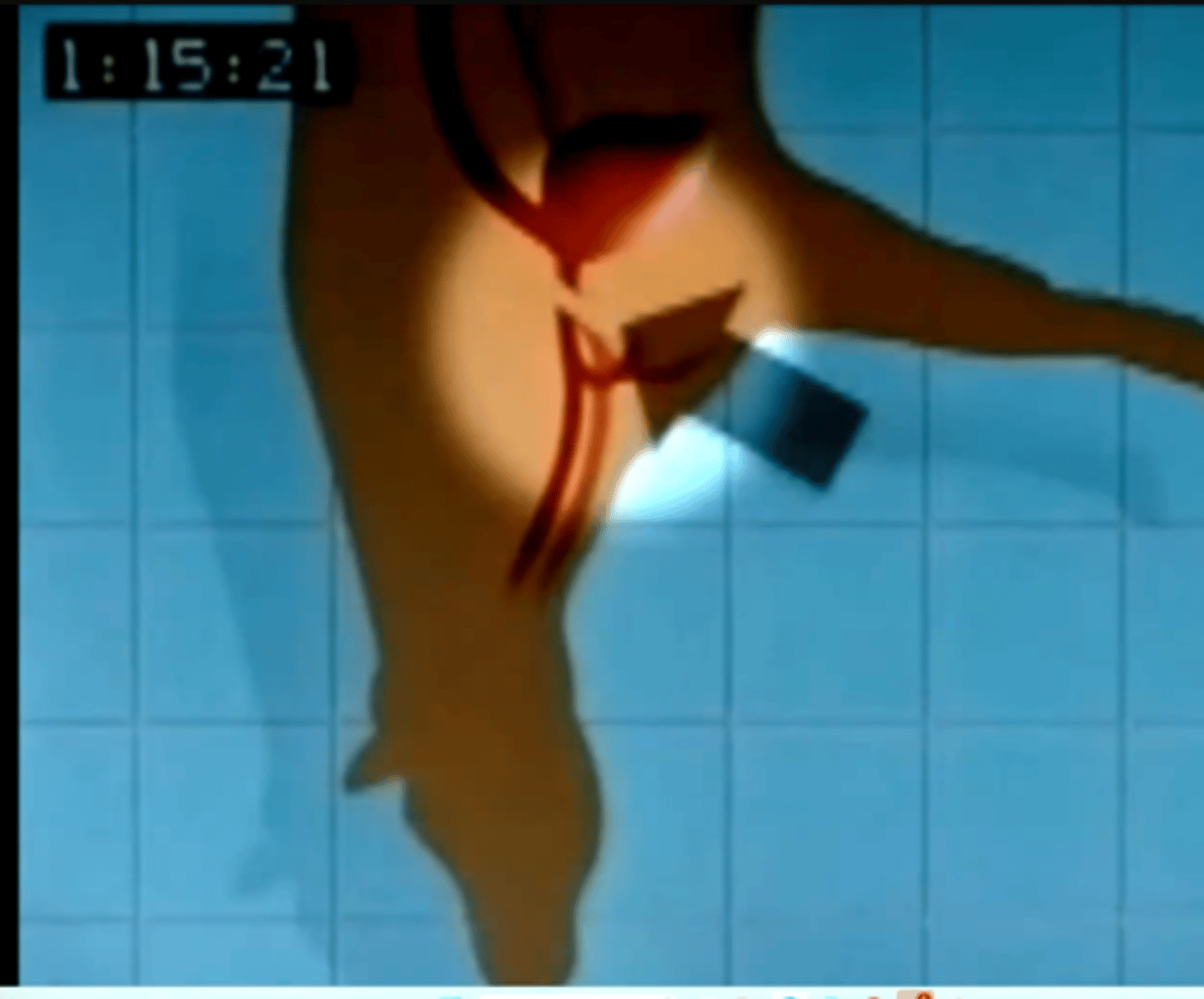Slaughter and Carcass Dressing of Food Production Animals
1/119
There's no tags or description
Looks like no tags are added yet.
Name | Mastery | Learn | Test | Matching | Spaced |
|---|
No study sessions yet.
120 Terms
What are the 14 points in the beef production flow diagram?
Ante-mortem inspection (on every single animal by OV but remember it is not a clinical exam) --> stunning --> shackling (to lift up) --> bleeding (method of kill, pithing not allowed in food chain) --> head removal --> hide (skin) removal --> evisceration --> splitting --> spinal cord removed --> trimming (slaughtermen correcting carcass for any contamination left) --> post-mortem inspection/marking (marked for post-mortem inspection, what organs/heat belong to which carcass. Health mark only applied when carcass deemed fit for human consumption and an identification mark for traceability) --> washing (not much cause we remove their skin) --> chilling --> quartering and deboning (only done in other side of plant/other plant but mostly without vet, vet only does monthly audit of this step to check for good hygiene).

why do we shackle cattle
to allow gravity to help evisceration
what is shackling
lifting up using chain
why is the head removed in cattle
for inspection (SRM)
Who must undergo splitting (cattle and sheep)?
Every cow and sheep over 12 months old.
what age is spinal cord removal required in cattle
12+ months
what do you do if the carcasse has missing organs
you cannot put them into human consumption because there could be pathology
why is health marking done
trace the meat back to the abattoir
what do you do with the health mark
never leave the health mark unattended, only the OV can use it and hand it out
what temperature can meat leave the abattori
7 degrees or below, to leave the abattoir
do beef cattle have to be split
over 12 months old so you can remove the spinal cord, using a hoover technology
what can you not present for post mortem
spinal cord
what is required for a thorough post mortem
the organs and head according to the animal
what is Evisceration
The displacement of organs outside of the body (for post-mortem inspection).
What is an extra part of post-mortem inspection in beef cattle?
Look at head after removal (post mortem inspection)
What are the 12 points in the lamb production flow diagram?
Ante-mortem inspection (on every single animal by OV but remember it is not a clinical exam) --> stunning --> shackling --> bleeding --> head removal (but just binned not kept for post-mortem like in cattle because no market for sheep brains in the UK)and hide removal --> evisceration --> splitting --> trimming --> marking --> washing --> chilling --> deboning

why is lamb head not inspected in the same way as cattle
no market for it, gets disposed of
What doesn't happen in pork production to the carcass that does happen to beef and sheep carcasses?
Hide and head removal.
what is scalding
water bath at 60 degrees to losen hair
what is hair removal
pig is rolled and then potentially singed (decontaminates) and polished (contaminates) followed by cleaning to remove hair for aesthetic
do pigs have to be split
as long as you can post mortem the pig doesnt have to be split
What are the 15 points in the pork production flow diagram?
Ante-mortem inspection (on every single animal by OV but remember it is not a clinical exam)--> stunning --> shackling --> bleeding --> scalding (into tank of hot water or steam tunnel to loosen hair follicles) --> dehairing --> singing (flames that burn of excess hair) --> polishing (to remove burnt bits from singing) --> washing --> evisceration --> splitting (apart for pigs for hog roasts) --> washing --> health mark --> chilling --> deboning

What is council regulation (EC) No 1099/2009?
Council regulation on the protection of animals at the time of killing.
What does killing mean under EC No. 1099/2009?
Killing means any intentionally-induced process which causes the death of an animal
What does animal mean under EC No. 1099/2009?
Animal means any vertebrate animal excluding reptiles and amphibians
What does emergency killing mean under EC No. 1099/2009?
Emergency killing means the killing of animals which are injured or have a disease associated with severe pain or suffering and where there is no other practical possibility to alleviate this pain or suffering (welfare reason)
What does stunning mean under EC No. 1099/2009?
'Stunning' means any intentionally-induced process which causes loss of consciousness and sensibility without pain
What does slaughter mean under EC No. 1099/2009?
(j) ‘slaughtering’ means the killing of animals intended for human consumption.
stun to kill methods
gas and full body electric (cattle)
simple stunning methods
head electric and captive bolt
why do you have to bleed after simple stunning
to kill them, as welfare
why do we bleed after stunning to kill
quality of meat, the blood goes into the m after it has been stunned
What is the definition of stunning?
Any intentionally-induced process which causes loss of consciousness and sensibility without pain, including any process resulting in instantaneous death - the loss of consciousness and sensibility shall be maintained until the death of animal

What are the 3 aims of stunning?
Kill/ slaughter humanely
Obtain the maximum amount of blood from the animal (increases quality of meat to remove as much blood as possible)
Health and safety

When must you stun animals?
Must stun all animals before you kill them unless carrying out religious slaughter
how shall animals be killed after stunning
in accordance with the methods and specific requirements related to the application of those methods set out in Annex I.
The loss of consciousness and sensibility shall be maintained until the death of the animal.
The methods referred to in Annex I which do not result in instantaneous death (hereinafter referred to as simple stunning) shall be followed as quickly as possible by a procedure ensuring death such as bleeding, pithing, electrocution or prolonged exposure to anoxia;
What must happen when you stun an animal?
When you stun an animal it must remain unconscious and unable to feel pain until death
What must you do to an animal immediately after stunning?
Must kill the animal immediately
What are 2 potential stunning methods that can be used?
Can use stunning methods that kill it immediately (e.g. gun/ rifle = stun to kill)
Simple stunning
what is simple stunning
where you stun an animal unconscious but don't instantly kill it (must ALWAYS immediately use a follow-up procedure to kill the animal before it recovers consciousness, e.g. bleeding = cutting both neck arteries = carotid arteries)
What does a certificate of competence (CoC) show a slaughterman can do (9 points)?
Handle animals
Stun animals
Pith animals
Restrain animals
Shackle animals
Hoist animals
Bleed live animals
Check stunning has worked
Check pithing has worked
what can vets do if a person with a CoC does not treat animals with welfare standards
suspend and revoke confidence
What are the three methods of stunning under EC 1099/2008 and WATOK?
- Captive bolt (cattle)
- Electronarcosis (Pigs and sheep)
- Gas (Pigs and poultry)
What are the 2 captive bolts that can be used?
Penetrative captive bolt
Non-penetrative captive bolt - for simple stunning on cattle, sheep, goats and deer (ruminants) under 10kg
What are 5 key features about captive gun pistols?
Blank cartridge (e.g. .22 or .25)
Thicker skull = bigger charge (bull/ boar)
Occasionally compressed air
Speed of bolt important (hollow better)
Note - captive bolt pistols are humane stunners not killers
What are 5 physiological effects of the captive bolt gun?
Heavy blow = acceleration of the head = brain impact (physical damage)
Damage to nerves and blood vessels
Massive rise then fall in pressure
Disruption of normal electrical activity
Duration depends on severity of damage
What are 6 signs of an effective stun with a captive bolt gun?
Collapse
No rhythmic breathing
Fixed glazed expression
No corneal reflex
Relaxed jaw
Tongue hanging out
What are the 3 phases after stunning?
Tonic phase = 10-20 seconds,
animal collapses and stops breathing,
becomes rigid,
head extended/ hindlegs flexed,
forelegs gradually straightening out
Clonic phase = involuntary kicking
Relaxation = walking/ paddling movements
What are 8 key points about captive bolt stunning?
Need formal training and OV supervision
Use correct type of equipment
Use restraint for accurate shooting
Correct site
Production of full tonic phase
Minimal stun to stick time
Regular cleaning and maintenance
Need a back up stun method if bot doesn't work
What is electronarcosis?
Electric stunning
What are the 2 types of voltage used in electronarcosis?
Low voltage system = 7 second application
High voltage systems = 3 second application
What are 2 electronarcosis methods and what are their outcomes?
Head only = possibly reversible
Head to body = cardiac arrest = irreversible
What form of electronarcosis should never be carried out and why?
Body only, induces cardiac arrest in a live animal
What is mandatory for electronarcosis?
Minimum current device
cattle older than 6 months minimum current
1.28 A
cattle younger than 6 months minimum current
1.25 A
sheep and goats minimum current
1.0 A
pig minimum current
1.3 A
how can you reduce resistance
with warm water
What happens for all animals during the tonic and clonic phases of electronarcosis?
Sticking/bleeding (when you cut their throat/kill them).
Why do we stun animals? (Inducing an epileptic fit)
Makes them uncious and insensible to pain.
What happens in the clonic phase (epileptic fit) after stunning?
Gradual relaxation, walking/paddling movements, downward rotation of eyes, foaming/urination
In what phase of stunning is required to kill the animal?
The tonic phase, then stick/bleed before the clonic phase ends (like up to 60 secs from stunning).
Will you be able to tell if a stunned animal is regained concioiusness?
No, they can recover quietly, regaining conciousness.
What happens in the tonic phase (epileptic fit) after stunning?
Rigid/rhythmic breathing stops, head raised and hind legs flexed.
if there is no tonic phase in epileptic fit what is there not
no stun
What are 6 key points about electronarcosis to remember?
Delivery of required current and correct setting of equipment
Accurate positioning of electrodes
Good contact (electrodes/ animal)
Classic epileptic fit produced
Stun to stick no more than 15 seconds (best practice/ legally within tonic/ clonic)
Operator training, servicing of equipment and supervision
What are the 3 gas mixture options for gassing animals?
Carbon dioxide at high concentration (at least 80%)
Carbon dioxide mixed with inert gases (e.g. argon, nitrogen)
Inert gases (e.g. hydrogen, argon)
Which animals is gassing often used in?
Commonly used to kill pigs and poultry, especially in large abattoir operations
What is the minimum concentration of carbon dioxide that has to be used in high concentration carbon dioxide gassing and what must this exposure lead to and how is this method performed?
Minimum concentration = 80% - exposure of conscious pigs to the gas must lead to anoxia (loss of oxygen to the brain and as a result death).
They are lowered into a pit where CO2 lies at the bottom (heavier than air so O2 at the top then CO2 concentrated at the bottom.
AN EFFECTIVE GAS STUNNER KILLS THE PIG.
When mustn't pigs enter a high concentration carbon dioxide gas stunner (called stun method but it stuns and then kills them together, the bleeding occurs post mortem and isn't what kills them)?
Pigs mustn't enter the gas stunner if the carbon dioxide concentration by volume falls below 80%
When must a pig be conveyed to the maximum concentration of gas by in a high concentration carbon dioxide gas stunner?
A pig must be conveyed to the maximum concentration of gas within 30 seconds of entering the stunner
What is the percentage of gas pigs must be exposed to if being gassed with carbon dioxide and inert gases?
Pigs must be exposed directly or progressively to a gas mixture containing up to 40% of carbon dioxide mixed within inert gases
What must be the result of gassing pigs with carbon dioxide and inert gases?
The maximum concentration if 40% carbon dioxide - direct or progressive exposure of conscious pigs to the gas must lead to anoxia (death and same method as before).
What 2 things must happen if gassing pigs with inert gases? Name these gases.
Nitrogen and argon.
Exposure must lead to anoxia (then death same method as before).
why might inert gases not or be chosen
takes longer
more expensive than CO2
is better welfare wise
what animal is nitrogen used for
only poultry
What are 9 pieces of equipment involved in gas killing (they must exit the gas chamber dead and bleeding is done post mortem)?
- Chamber to contain pigs/ carbon dioxide/ air and conveyer system
- Flush the stunner with air so staff can enter the chamber
- Back-up mechanical device
- Visually monitor pigs in the gas stunner
-Access the pigs as quickly as possible (bleeding after gas stunning)
-Allow pigs to remain standing until they lose consciousness
-Enough space for pigs to lie down without lying on each other
-Adequate lighting to allow pigs to see other pigs and their surroundings
-Gas stunners and their conveyers mustn't injure or bruise pigs or compress a pig's chest
if using gas for stunning what else should there always be
a backup method
What are 4 signs of an effective stun when gassing?
Recumbent animal limbs and jaw relaxed
No voluntary movements or righting reflexes present
No response to pin prick on nose
Absence of normal breathing
What are 5 advantages of gas stunning?
No excitement→ reduces potential issues in meat qual
Completely relaxed - easy bleeding
Non-invasive
Reduced blood splash
Reduced pale soft exudative (PSE)
What are 2 disadvantages of gas stunning?
Very expensive - only used for large throughputs
Welfare doubts - acidic gas is pungent to inhale at >40%, potent respiratory stimulant = breathlessness, not instantaneous.
use of argon as gas
argon is not iversive - does not cause pain, but takes 240s = expensive and difficult to procure
how is gas stunning used
pigs are lowered into a pit of gas, as CO2 and argon are heavier than air
is nitrogen heavier than air
no
helium as gas killer
redesign abattoirs, expensive hard to procure, and and lighter than air
are pigs handled using gas stunning ?
no. pre stun welfare is much better, they follow each other,
What phase is it best to bleed an animal during?
The tonic phase
What vessels does the neck cut affect and which animals is it used in?
Carotids and jugulars
Small ruminants

What vessels does the thoracic stick affect and which animals is it used in and why?
Ascending aorta
Cattle and pigs- for a better bleed out, and their(pigs and cattle) vessels to the brain are near the spine so more difficult to cut by cutting the head and the thoracic ones are more easily accessible in the chest close to where they emerge from the heart.

What 4 factors affect bleeding?
Health of animals
Rest prior to slaughter (muscle tone)
Back bleeding into thoracic cavity
Blood splashing = capillary rupture - could be related to increased blood pressure, electrical stunning (more common), stress, diet, physiological or genetic factors
why is gas still used when electric is an option
electric is slower and pre stun handling. need to redesign electrical stunning for pigs, but it is expensive and takes time.
What are 2 ways in which scalding can be carried out?
Vertical scalding steam
Tank scalding

Which animals is dehairing used in?
Pigs
Where are 2 places impact can happen in dehairing?
Impact in the grambling table
Impact between carcasses
What is a problem with dehairing?
Risk of contamination - e.g. faeces (have to be washed after)
Which animals is singing done in?
Pigs
What is the role of singing?
Eliminates the remaining hair on the surface of the carcass at a temperature of 1,000ºC
Why was singing added into pig meat production?
Step added in the process in regard of meat quality - also improves meat safety
What animal is polishing used in?
Pigs